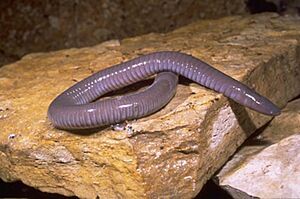Dermophis mexicanus facts for kids
Quick facts for kids Dermophis mexicanus |
|
|---|---|
 |
|
| Conservation status | |
| Scientific classification | |
| Genus: |
Dermophis
|
| Species: |
mexicanus
|
| Synonyms | |
|
|
The Dermophis mexicanus, often called the Mexican burrowing caecilian or the Mexican caecilian, is a very interesting animal. Locally, people might call it the tapalcua or tepelcua. It is a type of amphibian that does not have any legs. It belongs to the family Dermophiidae. This species lives in Mexico and Central America, where it digs tunnels under leaves and other plant material.
Contents
What Does It Look Like?
An adult Mexican burrowing caecilian can grow to be about 30 to 50 centimeters (12 to 20 inches) long. It looks a lot like a large earthworm. Its skin has about one hundred rings, called annular folds, which make it seem like it has segments.
Its head has a pointy snout. It has a single row of teeth in its lower jaw. It also has two tiny eyes that are covered by skin, so it cannot see very well. Between its eyes and nostrils, it has a pair of special tentacles that can stick out. These tentacles help it sense its surroundings. Its body is long and slender, and it does not have any limbs. The top of its body is dark grey, and its underside is light grey with darker marks on the rings.
Where Does It Live?
The Mexican burrowing caecilian is found in several countries. These include Mexico, Guatemala, El Salvador, Honduras, and Nicaragua. It might also live in Belize. It mostly lives on the Atlantic side of these countries, but you can also find it in some areas on the Pacific side.
Its natural habitats are warm, dry forests or moist lowland forests. It also lives in moist montane forests, which are forests found in mountains. You can even find it in plantations, like those growing bananas or coffee, and in rural gardens. It likes damp, loose soil and hides under leaf litter, logs, and other plant debris. It can live at heights of up to 1,200 meters (about 3,900 feet) above sea level.
What Does It Eat?
The Mexican burrowing caecilian eats small animals without backbones, called invertebrates. Its diet includes earthworms, termites, crickets, slugs, and snails. On nights when there is light rain, it sometimes comes out onto the ground. It catches small prey that come close enough for it to grab. Bigger caecilians might even eat mice or small lizards. This animal moves by making its body expand and contract like an accordion, or by wiggling from side to side.
How Does It Reproduce?
The Mexican caecilian is viviparous, which means it gives birth to live young instead of laying eggs. The male fertilizes the female's eggs inside her body. Up to 16 young caecilians can develop inside the mother. For the first three months, they get their food from the yolk of their eggs.
After this, they develop special rasping teeth. They use these teeth to gently scrape the inside of their mother's oviduct (the tube where they grow). This scraping encourages the mother's body to produce a special milky fluid, which the young then feed on. After about 11 months of growing inside their mother, they are born. When they emerge, they are about 10 to 15 centimeters (4 to 6 inches) long. Soon after birth, they lose their larval teeth and quickly grow a set of adult teeth.
Is It Safe?
The Mexican burrowing caecilian is listed as "Least Concern" on the IUCN Red List of Threatened Species. This means that, for now, it is not considered to be in danger of disappearing. However, its populations are spread out in different areas. In places where it used to be common, it now seems to be less abundant, and it is found in fewer locations. Sometimes, people might harm it because it looks a lot like a snake, even though it is an amphibian.


